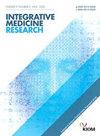Common adverse events of herbal formulas for developing reporting forms for clinical practice and research: An overview of systematic reviews
IF 3
4区 医学
Q2 INTEGRATIVE & COMPLEMENTARY MEDICINE
引用次数: 0
Abstract
Background
Previous research has mainly focused on the adverse events (AEs) of individual medicinal plants rather than those of herbal formulas. This study investigated AEs associated with herbal formulas composed of two or more herbs by summarizing existing systematic reviews (SRs). We aimed to identify common AEs to develop a comprehensive reporting form for clinical practice and research, improving herbal medicine safety monitoring in South Korea.
Methods
Four international (MEDLINE, EMBASE, CENTRAL, CINAHL) and three Korean databases (KISS, ScienceON, OASIS) were searched for SRs on AEs associated with herbal formulas from inception to September 13, 2024. Inclusion criteria were SRs focusing on AEs of herbal formulas composed of two or more herbs. Two researchers independently conducted the search, selection, and data extraction. Methodological and reporting quality were evaluated using A MeaSurement Tool to Assess systematic Reviews 2 and the Preferred Reporting Items for Systematic Reviews and Meta-Analyses 2020 checklist. AEs were classified using the System Organ Class of the Medical Dictionary for Regulatory Activities.
Results
Thirteen SRs were selected. The most frequently reported organ system was hepatobiliary (9 SRs), followed by nervous and gastrointestinal systems (3 SRs each). Common symptoms in primary studies were nausea (n = 102), diarrhea (n = 80), and vomiting (n = 70). Causality was analyzed in 7 SRs using various scales. The methodological quality of the included SRs was critically low.
Conclusions
Our findings provide a foundation for developing a standardized AE reporting form for herbal formulas. Further high-quality reports with specific patient conditions, herbal constituents, and causality assessments are required to enhance herbal medicine safety monitoring and understanding.
Protocol registration
PROSPERO, CRD42023478440.
为临床实践和研究制定报告表格的草药配方常见不良事件:系统评价概述
以往的研究主要集中在单个药用植物的不良事件,而不是草药配方的不良事件。本研究通过总结现有的系统评价(SRs),调查了两种或两种以上草药组成的草药配方相关的ae。我们的目标是确定常见的ae,为临床实践和研究开发一个全面的报告表格,改善韩国的草药安全监测。方法检索4个国际数据库(MEDLINE、EMBASE、CENTRAL、CINAHL)和3个韩国数据库(KISS、ScienceON、OASIS),检索自成立至2024年9月13日与中药配方相关的ae的ssr。纳入标准是关注由两种或两种以上草药组成的中草药配方ae的SRs。两位研究人员独立进行了搜索、选择和数据提取。使用评估系统评价的测量工具2和2020年系统评价和荟萃分析的首选报告项目清单来评估方法学和报告质量。使用《医学词典》中的系统器官类对ae进行分类。结果共筛选出13例SRs。最常报道的器官系统是肝胆(9例),其次是神经系统和胃肠道(各3例)。初步研究的常见症状是恶心(n = 102)、腹泻(n = 80)和呕吐(n = 70)。采用不同量表对7例SRs进行因果关系分析。纳入的SRs的方法学质量非常低。结论本研究结果为制定标准化的中药配方AE报告表提供了基础。需要进一步的高质量报告,包括具体的患者情况、草药成分和因果关系评估,以加强草药安全监测和理解。协议注册普洛斯普洛斯,CRD42023478440。
本文章由计算机程序翻译,如有差异,请以英文原文为准。
求助全文
约1分钟内获得全文
求助全文
来源期刊

Integrative Medicine Research
Medicine-Complementary and Alternative Medicine
CiteScore
6.50
自引率
2.90%
发文量
65
审稿时长
12 weeks
期刊介绍:
Integrative Medicine Research (IMR) is a quarterly, peer-reviewed journal focused on scientific research for integrative medicine including traditional medicine (emphasis on acupuncture and herbal medicine), complementary and alternative medicine, and systems medicine. The journal includes papers on basic research, clinical research, methodology, theory, computational analysis and modelling, topical reviews, medical history, education and policy based on physiology, pathology, diagnosis and the systems approach in the field of integrative medicine.
 求助内容:
求助内容: 应助结果提醒方式:
应助结果提醒方式:


